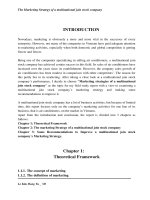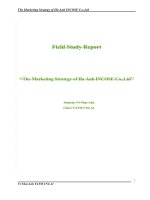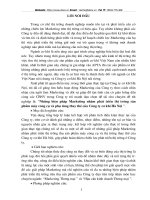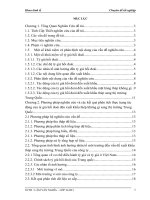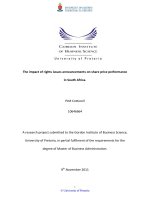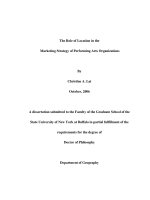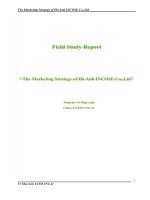The Marketing Strategy of Ha Anh INCOSE Co.,Ltd.doc
Bạn đang xem bản rút gọn của tài liệu. Xem và tải ngay bản đầy đủ của tài liệu tại đây (236.11 KB, 36 trang )
The Marketing Strategy of Ha Anh INCOSE Co.,Ltd
Field Study Report
‘‘The Marketing Strategy of Ha Anh INCOSE Co.,Ltd’’
Student: Vi Nhat Anh
Class: TATM CN6 A1
Vi Nhat Anh TATM CN6 A1
1
The Marketing Strategy of Ha Anh INCOSE Co.,Ltd
Hanoi, November 2009
Field Study Report
‘‘The Marketing Strategy of Ha Anh INCOSE Co.,Ltd’’
Student: Vi Nhat Anh
Class: TATM CN6 A1
Supervisor: Bui Nguyet Anh M.A
Hanoi, November 2009
Vi Nhat Anh TATM CN6 A1
2
The Marketing Strategy of Ha Anh INCOSE Co.,Ltd
Acknowledgements
In the process of writing this report, I have gained a great deal in terms of project planning,
research methodology and information acquisition. But I could never have done this work
without the help and advice of many whose ability far exceeds my own. With gratitude, I
acknowledge a specific debt to my supervisor, Ms Bui Nguyet Anh, for her invaluable
advice and personal guidance from the planning stage to the completion of this report.
My thanks also go to all my teachers at the Foreign Trade University for their devoted
teaching and for introducing me to the world of knowledge during my four and a half years
at the University. Their influence will remain with me for my entire life.
I would like to thank Ha Anh INCOSE Co.,Ltd for providing the information, data,
materials that enabled me to complete my report.
Finally, I wish to express my deepest appreciation to all people in my family for their love,
understanding and encouragement.
Vi Nhat Anh TATM CN6 A1
3
The Marketing Strategy of Ha Anh INCOSE Co.,Ltd
TABLE OF CONTENTS
Vi Nhat Anh TATM CN6 A1
4
The Marketing Strategy of Ha Anh INCOSE Co.,Ltd
INTRODUCTION
Nowadays, marketing is obviously more and more vital in the success of every enterprise.
However, not many of the companies in Vietnam have paid adequate attention to
marketing activities, especially when both domestic and global competition is getting
fiercer and fiercer.
Being one of the companies specializing in Production line and equipment for foodstuff
industry, mechanical engineering, construction machinery in Vietnam, Ha Anh
International Commercial Services Company Limited (HA ANH INCOSE CO.,Ltd) has
achieved certain successes in this field. Its sales of line and equipment for foodstuff
industry have increased over the years since its establishment. After taking a close look at
HA ANH INCOSE CO.,Ltd’ s performance, I decided to choose “Marketing strategies of
Ha Anh International Commercial Services Company Limited” as the topic for my field
study report with a view to examining Ha Anh International Commercial Services
Company Limited’s marketing strategy and making some recommendations to improve it.
Ha Anh International Commercial Services Company Limited has a lot of business
activities, but because of limited time, this report focuses only on the company’s marketing
activities for one line of its business, that is line and equipment for foodstuff industry, on
the market in Vietnam.
Apart from the introduction and conclusion, the report is divided into 3 chapters as follows:
Chapter 1: Theoretical Framework
Chapter 2: Marketing strategies of Ha Anh INCOSE Co.,Ltd
Chapter 3: Some Recommendations to Improve Ha Anh International Commercial
Services Company Limited’s Marketing Strategy
Chapter 1
Theoretical Framework
Vi Nhat Anh TATM CN6 A1
5
The Marketing Strategy of Ha Anh INCOSE Co.,Ltd
1.1. The concept of marketing
1.1.1. The definition of marketing
Today’s then central problem facing businesses is not a shortage of goods but a shortage of
customers. Most of the world’s industries can produce far more goods than the world’s
consumers can buy. Overcapacity is resulted from individual competitors projecting a
greater market share growth than is possible. If each company projects a 10 percent growth
in its sales and the total market is growing by only 3 percent, the result is excess capacity.
This in turn leads to hyper competition. Competitors, desperate to attract customers, lower
their prices and add give away. These strategies ultimately mean lower margins, lower
profits, more failing companies, and more mergers and acquisitions. Marketing is the
answer to how to compete on bases other than price. Because of over capacity, marketing
has become more important than over.
If forced to define marketing, most people, including some business managers, say that
marketing means “selling” or “advertising”. It’s true that these are parts of marketing. But
marketing is much more than selling and advertising. Today, marketing must be
understood not in the old sense of marketing a sale-“telling and selling”-but in the new
sense of satisfying customer needs. Selling occurs only after a product is produced.
In contrast, marketing starts long before a company has a product. “Marketing is the
homework that managers undertake to assess needs, measure their extent and intensity and
determine whether a profitable opportunity exists. Marketing continues throughout the
product’s life, trying to find new customers and keep current customers by improving
product appearance and performance, learning from product sales results and managing
performance”
1
. So what does the term “marketing” mean? Actually, there is no single and
universally agreed definition of marketing. The American Marketing Association defined
marketing “is the process of planning and executing the conception, pricing, promotion and
distribution of ideas, goods, and services to create exchanges that satisfy individual and
organizational goals”
2
.
The writer of the book “The Silk Road to International Marketing”
had another definition as follow: “Marketing is the process by which decisions are made in
a totally interrelated changing business environment on all the activities that facilitate
Vi Nhat Anh TATM CN6 A1
6
The Marketing Strategy of Ha Anh INCOSE Co.,Ltd
exchange in order that the targeted group of customers is satisfied and the defined
objectives accomplished ”
3
.
Though there are many definitions, a central part of any
definitions of marketing is the exchange process – the process of giving something of value
in return for something of value. Or in other words, it’s the process of transferring between
two or more parties of tangible or intangible items of value(see figure 1.1).
Cash, debt, time, votes, behavior, etc
Health, safety, comfort, transportation, beauty, productivity, etc.
Figure 1.1: the exchange process
Source: Courtland L. Bovee, Jonh V. Thill , “Marketing”, 2
nd
edition, p.6.
For marketing to occur, at least four factors are required: (1) two or more parties with
unmet needs, (2) a desire and ability to satisfy them, (3) communication between the
_______________________
1
Amber, T.and Styles, C.(2000), The Silk Road to International Marketing, Harlow: FT Prentice Hall
2
Arch G. Woodside(1990), Outdoor advertising as experiments, Journal of the Academy of Marketing science.
3
Berkkowitz, Kerin, Hartley, Rudelius, (1990), Marketing, 2
nd
edition, Irwin McGrawHill.
parties, and (4) something to exchange
4
. Here’s what Berkowitz stated in his book
“Marketing”. As marketing is a kind if exchange, certain conditions must exist before the
exchange can occur.
1.1.2. The goals of marketing.
Vi Nhat Anh TATM CN6 A1
7
Marketer
Goods, Services,
ideas,
People and Places
Customers
Wants and needs.
The Marketing Strategy of Ha Anh INCOSE Co.,Ltd
“Today’s successful companies at all levels have one thing in common; their success is
founded upon a strong customer focus and heavy commitment to marketing”
5
. They
motivate everyone in the organization to deliver high quality and superior value for their
customers, leading to high levels of customer satisfaction. These organizations know that if
they take care of their customers, market share and profits will follow. Creating customer
values and satisfaction is at the very heart of modern marketing thinking and practice. The
goal of marketing is to attract new customers by promising superior values, and to keep
current customers by delivering satisfaction. When a company succeeds in creating more
values for customers than its competitors can do, that company is said to enjoy competitive
advantage in an industry.
1.2. Competitive Analysis
It is the increasingly emerging markets that have created favorable conditions for the rapid
development of world trade and investment, which is well – manifested in the sophisticated
growth of a number of global companies. To compete in one or more foreign markets,
companies not only need to broaden relentlessly their sources of competitive position. One
particularly useful technique in analyzing a firm’s competitive position relative to its
competitors is SWOT (strengths. Weaknesses, opportunities, and threats) analysis aims to
isolate the key issues that will be important to the future of the firm and that will be
addressed by subsequent marketing strategy. A SWOT analysis divides the information
into two main categories (internal factors and external factors)
_________________________
4
Courtland L. Bovee, Jonh V. Thill, (2000), “Marketing”, 2
nd
edition
5
Crag, C.S and Douglas, S.P. (2000), International Marketing Research, Chichester: Wiley
and then further into positive aspects (strengths and opportunities) and negative aspects
(weaknesses and threats).
The internal factors could be viewed as strengths or weaknesses, depending upon their
impact on the firm’s positions; i.e., they may represent strength for one firm but a
Vi Nhat Anh TATM CN6 A1
8
The Marketing Strategy of Ha Anh INCOSE Co.,Ltd
weakness, in relative terms, for another. They include all of the marketing mix (product,
price, promotion and place strategy) as well as personnel and finance.
The external factors, which again may pose a threat to one firm but create opportunities to
another, include technological changes, legislation, socio-cultural differences, and change
in the market place or competitive position.
1.3. Global Marketing Strategy
In terms of globalization, worldwide businesses use global marketing when they take the
same or similar approach or content for one or more elements of the marketing mix, that is,
the same or similar brand names, advertising. And so on in different countries. Although
most of the multinational companies using global marketing mix-product, pricing,
promotion and place – are standardized. Business can make some elements of marketing
more global and others less so. Accordingly, possible adaptations that firms might apply to
their product, promotion, price, and place when they enter through the foreign markets will
be provided in this part.
1.3.1. Product
There are five international product and promotion strategies for a company to extend its
market base into other geographic markets (See table 1.1).
Straight extension means marketing the product in the foreign market without any
adaptation. Top manager asks its marketing people to “find customers for the product as it
is”. As a result, it is seen as the easiest product marketing strategy and may be the most
profitable one as well. However, the company should first determine whether foreign
consumers use that product or not. Straight extension has been successful with cameras
consumer electronics, and many machine tools. This strategy is tempting because it
involves no additional product development cost, manufacturing changes, or promotional
modification. But it can be costly in the long run if products fail to satisfy foreign
consumers.
Table 1.1: Five international product and promotion strategies
Vi Nhat Anh TATM CN6 A1
9
The Marketing Strategy of Ha Anh INCOSE Co.,Ltd
Product
Promotion
Do not change
product
Adapt product Develop new
product
Do not change
promotion
Straight extension Product adaptation
Adaptation
promotion
Communication
adaptation
Dual adaptation
Product
invention
Source: Subhash C.Jain (1995), international marketing management
Product adaptation involves changing the product to meet local conditions or preferences.
There are several levels of adaptation. A company can produce a regional version, a
country version, a city version or even promotion retailer versions of its products.
Although, products are frequently adapted to local tastes, in some instances they must be
adapted to local superstitions or beliefs, too.
Product invention consists of creasing something new the foreign market. It can be divided
into two forms. The first is backward invention, which means reintroducing earlier
products forms that happen to be well adapted to the needs of a given country. And forward
invention is to create a new product to meet a need in another country.
6
1.3.2. Promotion
Companies can either adopt the same promotion strategy they used in home market or
change it to suit each local market. Although some global companies use a standardized
promotion campaign changes might be needed to comply with local regulations and
references. There are four different levels of adapting promotion strategy.
_______________________
6
Subhash C.Jain (1995), International Marketing Management
Firstly, companies can use one message everywhere, varying only the language, name, and
colors. That is because colors might be changed to avoid taboos in some countries.
Also, names and slogan may have to be modified in some countries. Secondly, companies
may use the same name globally but adapt the copy to each local market. Thirdly,
companies can develop a global pool of advertising from which each country selects the
Vi Nhat Anh TATM CN6 A1
10
The Marketing Strategy of Ha Anh INCOSE Co.,Ltd
most appropriate one. Finally, some companies allow managers to create a specific
advertisement – within guidelines, of course.
Other companies follow a strategy of communication adapting their advertising messages
without any product change. Although it retains the scale economy on the manufacturing
side the firm sacrifices potential saving on the communication way. Another strategy is
dual adaptation. It is changing both the product and the communication to face local
differences.
1.3.3. Price
Global companies face several problems in setting their international prices. Those
problems must be dealt with price escalation, transfer prices, dumping charges, and black
markets.
Price escalation problem occurs when companies sell their goods abroad. The foreign
prices probably will be higher than their domestic ones because it must add the cost of
transportation, tariffs, importer margin, wholesaler margin, and retailer margin. Depending
on these added costs, the product may have to sell for two to five times as much as in
another country to generate the same profit. Since cost escalation varies from country,
companies have three price setting approaches in different countries.
Setting a uniform price everywhere: charging the same price everywhere in the world. By
this method, companies would have quite different prices in different countries because of
varying escalation costs. Also, this strategy would result in too high price in poor countries
and not high enough in rich countries.
Setting a market-based price in each country: charging what each country could afford. But
this strategy ignores differences in the actual costs from country to country. In addition, it
could lead to a situation in which intermediaries in low-price countries reship to high-price
countries. Setting a cost-based price in each country: using a standard markup of its costs
everywhere. But this strategy might price out of the market in countries where costs are
high.
Another problem arises when a company sets a transfer price (i.e., the price that it charges
to another unit in the company) for goods that it ships to its foreign subsidiaries. If a
Vi Nhat Anh TATM CN6 A1
11
The Marketing Strategy of Ha Anh INCOSE Co.,Ltd
company charges too high a price to a subsidiary, it may end up paying higher tariff duties,
even while paying lower income taxes in that country. If company charges its subsidiary
too little, it can be charged with dumping. Dumping occurs when a company charges either
less than it costs or less than it charges in its home market, in order to enter or win a
market.
7
Various governments are watching for abuses and often force companies to charge
the arm’s-length price – that is, the price charged by other competitors for the same or a
similar product.
Global companies also face the black-market problem. A black market means the same
product is sold at different prices geographically. Dealers in the lower-price country find
ways to sell some of their products in higher-price countries, thus earning more.
8
Very
often a company finds some distributors buying more than they can sell in their own
country and reshipping goods to another country to take advantage if there are price
differences. Multinationals try to prevent black market by policing the distributors, by
raising their prices to lower-cost distributors, or by altering the product characteristics or
service warranties for different countries.
Moreover, one challenge of global pricing in recent years is that countries with
overcapacity, cheap currencies, and the need to export aggressively have pushed prices
down and devalued their currencies. For multinational firms this poses great difficulties.
Sluggish demand and reluctance to pay higher price make selling in these emerging
markets harder. Instead of lowering prices, and taking a loss, some multinationals have
found more lucrative and creative means to deal with this problem.
_____________________________
7
Keegan, Warren J.(1995), Multinational Marketing Management
8
Kotler, Philip(2000), Marketing Management.
1.3.4. Place (distribution channels)
Global companies must take a whole-channel view of the problem of distributing products
to final consumers. Figure 1.2 show the three major links between the seller and the
Vi Nhat Anh TATM CN6 A1
12
The Marketing Strategy of Ha Anh INCOSE Co.,Ltd
ultimate user. In the first link, seller’s international marketing headquarters the export
department or international division makes decisions on channels and other marketing-mix
element.
9
The second link, channels between nations, maces the products to the borders of
the foreign nations.
10
The decisions made in this link include the types on intermediaries
(agents, trading companies) that will be used, the type of transportation (air, sea), and the
financing and risk arrangements. The third link, channels within foreign nations, moves the
products from their foreign entry point to final consumers.
11
Channels of distribution within countries vary greatly from nation to nation first, there are
large differences in the numbers and types of intermediaries serving each foreign market.
Long channels of distribution means that the consumer’s price ends up double or triple the
importer’s price. Another difference lies in the size and character of retail units abroad.
Breaking bulk remains an important function of intermediaries and helps perpetuate the
long channels of distribution, which is a major obstacle to the expansion of large-scale
retailing in developing countries.
1.4. The marketing mix strategies
Philip Kotler, in his book “Principles of Marketing”; defines marketing mix as “the set of
controllable tactical marketing tools – product, price, place and promotion – that the firm
blends to produce the response it wants in the target market”
12
. These ingredients must be
manipulated in a manner which ensures targeted customers are satisfied, marketing
strategies are implemented and desired brand positioning is achieved.
_______________________
9,10,11
Charlers Hill(1997), International Business
12
Philip Kotler, Gery Armstrong, John Saunders, Veronica Wong, principles of Marketing, 2
nd
edition,p.97
Figure 1.2: whole-channel concept for international marketing.
Vi Nhat Anh TATM CN6 A1
13
